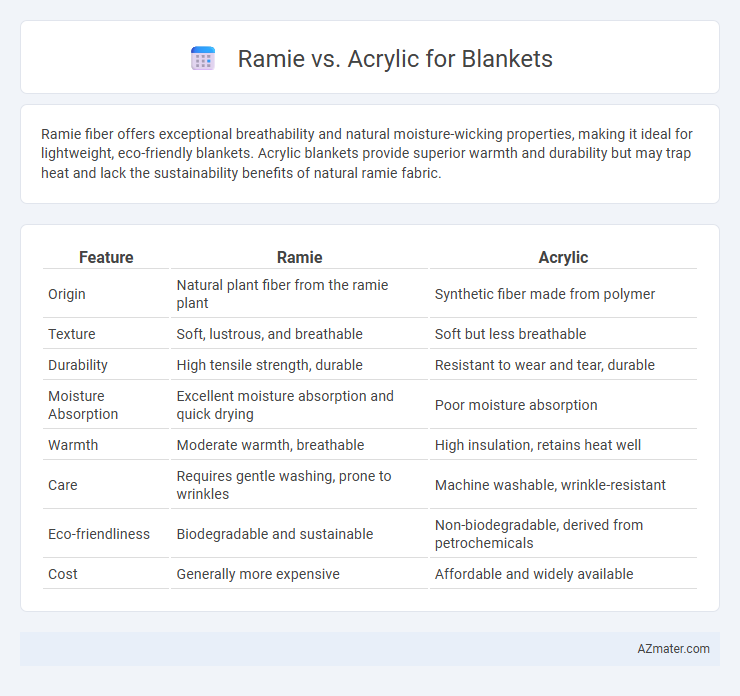Ramie fiber offers exceptional breathability and natural moisture-wicking properties, making it ideal for lightweight, eco-friendly blankets. Acrylic blankets provide superior warmth and durability but may trap heat and lack the sustainability benefits of natural ramie fabric.
Table of Comparison
| Feature | Ramie | Acrylic |
|---|---|---|
| Origin | Natural plant fiber from the ramie plant | Synthetic fiber made from polymer |
| Texture | Soft, lustrous, and breathable | Soft but less breathable |
| Durability | High tensile strength, durable | Resistant to wear and tear, durable |
| Moisture Absorption | Excellent moisture absorption and quick drying | Poor moisture absorption |
| Warmth | Moderate warmth, breathable | High insulation, retains heat well |
| Care | Requires gentle washing, prone to wrinkles | Machine washable, wrinkle-resistant |
| Eco-friendliness | Biodegradable and sustainable | Non-biodegradable, derived from petrochemicals |
| Cost | Generally more expensive | Affordable and widely available |
Introduction to Ramie and Acrylic Fibers
Ramie is a natural fiber derived from the stalks of the Chinese nettle plant, prized for its durability, breathability, and silky texture, making it an eco-friendly choice for blankets. Acrylic fibers are synthetic, designed as wool substitutes with excellent warmth retention, softness, and resistance to moths, mold, and mildew, ideal for easy-care blankets. Comparing ramie and acrylic involves considering factors like moisture absorption, environmental impact, and tactile comfort, which are key for selecting the best blanket material.
Key Characteristics of Ramie Blankets
Ramie blankets are known for their exceptional breathability, moisture-wicking properties, and natural luster, making them lightweight and comfortable for year-round use. The strong, durable fibers of ramie resist wear and maintain shape over time, offering sustainable alternatives compared to synthetic acrylic blankets. Ramie's hypoallergenic nature and resistance to bacterial growth provide added benefits for sensitive skin, distinguishing it from acrylic's often less breathable and synthetic feel.
Key Characteristics of Acrylic Blankets
Acrylic blankets are known for their exceptional softness, lightweight nature, and vibrant color retention, making them a popular choice for cozy, colorful throws. They offer excellent moisture resistance and quick-drying properties, which contribute to their durability and ease of care compared to natural fibers like ramie. Acrylic fibers also provide strong resistance to moths and mildew, ensuring the blanket maintains its quality over time with minimal maintenance.
Warmth and Insulation Comparison
Ramie fibers offer natural breathability but provide less warmth and insulation compared to acrylic, which is engineered for superior heat retention in blankets. Acrylic blankets trap heat effectively, making them ideal for colder climates, while ramie excels in moisture-wicking and cooling properties suited for mild temperatures. Selecting acrylic enhances warmth and insulation performance, whereas ramie prioritizes comfort and breathability.
Softness and Texture Differences
Ramie blankets offer a firmer texture with a natural, slightly coarse feel due to the plant-based fibers, providing breathability but less softness compared to acrylic. Acrylic blankets are known for their plush, smooth texture, mimicking wool with a lightweight and soft finish that enhances comfort. The choice between ramie and acrylic depends on preference for natural firmness versus synthetic softness in blanket materials.
Durability and Longevity
Ramie fibers offer superior durability due to their strong cellulose composition, making blankets resistant to wear and tear over time. Acrylic blankets, while soft and lightweight, tend to pill and degrade faster under frequent use and washing. Choosing ramie ensures longer-lasting blankets with enhanced durability for everyday comfort.
Maintenance and Care Requirements
Ramie blankets require gentle washing with mild detergent and air drying to maintain their natural luster and prevent shrinkage. Acrylic blankets are machine washable, quick-drying, and resist wrinkles, making them easier to care for with less risk of damage. Frequent washing of ramie can weaken fibers, while acrylic withstands regular laundering without significant wear.
Environmental Impact and Sustainability
Ramie blankets boast a significantly lower environmental impact compared to acrylic, as ramie is a natural fiber derived from the stalks of the Chinese nettle plant, which is biodegradable and requires fewer pesticides and less water than conventional cotton. Acrylic, a synthetic fiber made from petroleum-based chemicals, contributes to microplastic pollution and is not biodegradable, leading to long-term environmental harm. Choosing ramie over acrylic supports sustainability by reducing reliance on fossil fuels and promoting biodegradable textile waste.
Price and Availability
Ramie blankets tend to be pricier due to the labor-intensive process involved in harvesting and processing natural fibers, while acrylic blankets are generally more affordable because they are mass-produced from synthetic materials. Ramie fibers are less widely available, often sourced from specific regions in Asia, which can limit supply and increase costs; acrylic, on the other hand, is readily available worldwide, making blankets made from it easier to find in most retail stores. Consumers seeking budget-friendly options will often find acrylic blankets more accessible, whereas those prioritizing natural fiber qualities might face higher prices and limited availability with ramie products.
Which Is Better for Blankets: Ramie or Acrylic?
Ramie fibers offer natural breathability, moisture-wicking properties, and hypoallergenic benefits, making them ideal for lightweight, breathable blankets suited for warmer climates. Acrylic blankets excel in durability, softness, and affordability, providing warmth and easy maintenance, which suits colder environments and everyday use. Choosing between ramie and acrylic depends on whether you prioritize natural fiber comfort and breathability or synthetic fiber warmth and resilience.

Infographic: Ramie vs Acrylic for Blanket
 azmater.com
azmater.com